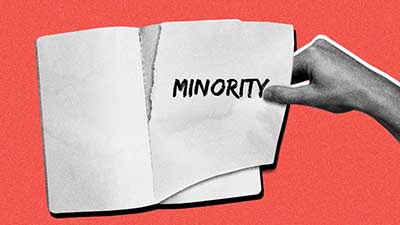Relevance: GS-2: Mechanism, laws, institutions, and Bodies constituted for the protection and betterment of vulnerable sections of society, minority status, etc
Key Phrases: Minority status, religious minority, linguistic minority, National Commission for Minorities (NCM) Act 1992, Article 29, Article 30, Article 350 A, TMA Pai case, BAL PATIL case.
Why in News?
- Every person in India can be a minority in one State or the other. The minority status of religious and linguistic communities is “State-dependent”, the Supreme Court said.
What is the case about?
- The court was hearing a petition filed complaining that followers of Judaism, Bahaism, and Hinduism, who are the real minorities in Ladakh, Mizoram, Lakshadweep, Kashmir, Nagaland, Meghalaya, Arunachal Pradesh, Punjab, and Manipur cannot establish and administer educational institutions of their choice because of non-identification of ‘minority’ at State level, thus jeopardizing their basic rights guaranteed under Articles 29 and 30.
- The petitioner challenged Section 2(c) of the National Commission for Minorities (NCM) Act 1992, which gave “unbridled power” to the Centre to notify minorities in defiance of the Supreme Court’s 11-judge Bench judgment in the T.M.A Pai case that linguistic and religious minorities should be identified at the State level and not the national level.
‘Minority’ in Indian Constitution:
- The expression “minorities” appears in some Articles of the Constitution but is not defined anywhere.
- Article 29, which deals with the “Protection of interests of minorities”, says that “any section of the citizens residing in the territory of India or any part thereof having a distinct language, script or culture of its own shall have the right to conserve the same”, and that “no citizen shall be denied admission into any educational institution maintained by the State or receiving aid out of State funds on grounds only of religion, race, caste, language or any of them”.
- Article 30 deals with the “right of minorities to establish
and administer educational institutions”.
- It says that all minorities, whether based on religion or language, shall have the right to establish and administer educational institutions of their choice.
- It says that “in making any law providing for the compulsory acquisition of any property of an educational institution established and administered by a minority, the State shall ensure that the amount fixed by or determined under such law for the acquisition of such property is such as would not restrict or abrogate the right guaranteed under that clause”, and that “the state shall not, in granting aid to educational institutions, discriminate against any educational institution on the ground that it is under the management of a minority, whether based on religion or language”.
- Article 350(A) says there shall be a Special Officer for
linguistic minorities to be appointed by the President.
- “It shall be the duty of the Special Officer to investigate all matters relating to the safeguards provided for linguistic minorities under this Constitution and report to the President upon those matters at such intervals as the President may direct, and the President shall cause all such reports to be laid before each House of Parliament, and sent to the Governments of the States concerned”.
Minority communities in India
- Currently, only those communities notified under section 2(c) of the National Minorities Commission Act, 1992, by the central government are regarded as a minority.
- In the exercise of its powers under Section 2(c) of the NCM Act, the Centre notified five groups — Muslims, Christians, Sikhs, Buddhists, and Parsis — as ‘minority’ communities in the year 1993.
- Jains were added to the list in January 2014.
TMA Pai case:
- In TMA Pai & others vs State of Karnataka & others 2002 case, an 11-judge bench of the Supreme Court dealt with the question of the scope of rights of minorities to establish and administer educational institutions of their choice under the Constitution.
- The SC had said that for Article 30 which deals with the rights of minorities to establish and administer educational institutions, religious and linguistic minorities have to be considered State-wise.
BAL Patil case:
- In 2005, the SC in its judgment in Bal Patil & Anr vs Union Of
India & Ors referred to the TMA Pai ruling and said:
- “After the verdict in the eleven judges’ Bench in TMA Pai Foundation case (supra), the legal position stands clarified that henceforth the unit for determining the status of both linguistic and religious minorities would be ‘state’.
- If, therefore, the State has to be regarded as the unit for determining “linguistic minority” vis-a-vis Article 30, then with “religious minority” being on the same footing, it is the State about which the majority or minority status will have to be determined.
Conclusion:
- Non-Uniform distribution of communities across India creates a conflicting situation in declaring X community a minority nationally, which in the certain State could be a majority.
- Constant migration of citizens disturbs demography. Changing the structure of religious or linguistic community now & then. Hence, no constant policy can be adhered to.
- With over 1500 regional languages the designation of linguistic minorities becomes cumbersome.
- Having a rigid minority group will be detrimental to society as a whole for a population boom in one group will significantly change demography.
- The possible solution could rather determine the minority status concerning the source and territorial application of legislation as pointed out in the TMA Pai case by the Honourable Supreme Court of India.
Source: The Hindu, Indian Express
Mains Question:
Q. The issues related to determination of ‘minority’ in India are to be revisited in the light of recent decision of Supreme Court. Discuss.







